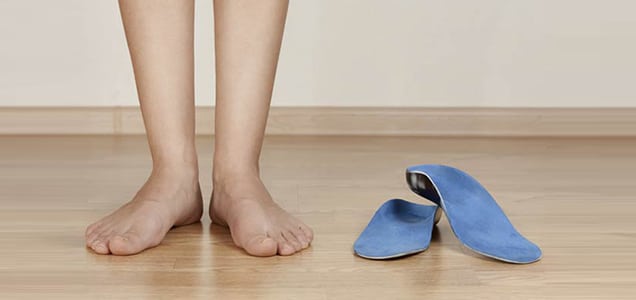DO ORTHOTIC INSOLES HELP PREVENT COMMON FOOT CONDITIONS

General Foot Health
More than three-quarters of Americans suffer from foot pain, according to statistics from the American Podiatric Medical Association (Foot & Ankle Foundation), including adults of all ages and from all walks of life. Chronic symptoms limited their activities, interfering with their ability to exercise, work, walk, and even engage in family activities.
Yet despite how common foot pain is — and the serious toll it can take on your life — many people don’t bother to seek medical care for their symptoms. That’s too bad, because many types of foot pain can be treated with relatively simple solutions and without surgery, injections, or long-term use of medications. In fact, some of the most common causes of foot pain can be treated with orthotic insoles, a completely noninvasive, option that can reduce pain not only in your feet but in your legs and lower back, as well.
5 Common Foot Conditions
Orthotic insoles can aid in treating lots of problems, including these five common causes of chronic foot pain.
Plantar fasciitis: The plantar fascia is a strong band of tissue that extends along the bottom of your foot, beginning at your heel. Sometimes, this band becomes inflamed or irritated, resulting in chronic pain along the bottom of the foot or focused around the heel. Plantar fasciitis becomes a lot more common with age, and it’s also common among athletes whose feet take a lot of pounding.
Bunions: Bunions form when the big toe is pushed in toward the rest of the toes, placing pressure on the lower toe joint. Over time, the joint can become “displaced” and deformed, resulting in a painful lump on the outside of the foot. In extreme cases, the big toe may be forced over the neighboring toes. People who wear tight or high-heel shoes are especially prone to bunions, and so are people with specific types of foot shapes.
Heel spurs: Heel spurs are bony growths that form along the edge of the heel bone. When these hard growths press on soft tissues or tendons, they can cause considerable pain and inflammation.
Neuromas: Neuromas are benign nerve growths or tumors that occur when a nerve becomes irritated and inflamed. In addition to pain, neuromas can also cause numbness and tingling. Morton’s neuroma is a common type of neuroma that forms in or near the ball of your foot. You can use orthotic insoles for Morton’s neuroma to find relief from pain or tingling sensation.
Tendinitis: There are lots of tendons in your feet, and any of them can become inflamed. One of the most common types of tendinitis involves the posterior tendon, which runs from the inside of the ankle to the middle of your foot. This tendon helps support your arch. A lot of impact activities or even long periods of standing can irritate this tendon and stress your arch.
Orthotic Insoles As A Solution To Common Foot Conditions
Orthotic insoles are medical devices that you wear inside your shoes to correct biomechanical foot issues such as problems with how you walk, stand, or run. They can also help with foot pain caused by medical conditions such as diabetes, plantar fasciitis, bursitis, and arthritis. Orthotics might even help you avoid surgery to fix flat feet.
Foot discomfort and structural problems such as the hammertoes and bunions caused by the inflammation of RA and lupus also can spread beyond the feet, leading to shin pain, knee pain and lower back pain.
Orthotics aid by redistributing weight and relieving pressure on sensitive areas of the feet. This in turn provides cushioning that reduces stress, or biomechanical load, on the lower body, and corrects gait and structural abnormalities (WebMD).
Most studies find that people who wear orthotics have less foot pain and need fewer pain-relieving medications and data suggests the inserts affect the foot’s very fine, or micro-, control of gait, subtly altering muscle activity and reducing stress on the lower extremity (Arthritis Foundation)
Alleviate Those Foot Conditions Now
When your feet hurt, it’s hard to think about anything else, and everyday activities that involve standing or walking for more than a few minutes can become overwhelming. Making good shoe choices can prevent problems, but for many of those who are already suffering, orthotic inserts may provide much-needed relief.
Proper alignment and support of the foot help to alleviate and prevent these conditions. SelectFlex offers the best over the counter orthotic insole for these purposes. SelectFlex Arch Control Insoles provide the customizeable arch support that you can only get from orthotics. Step into the prevention and alleviation of foot conditions and other ailments by giving your feet the support they need. Visit our website (www.SelecFlex.com) or call (844) 570-1862 to learn more about how you can give your body support, stability, alignment, cushioning, and mobility with orthotic insoles. Find out more today!











